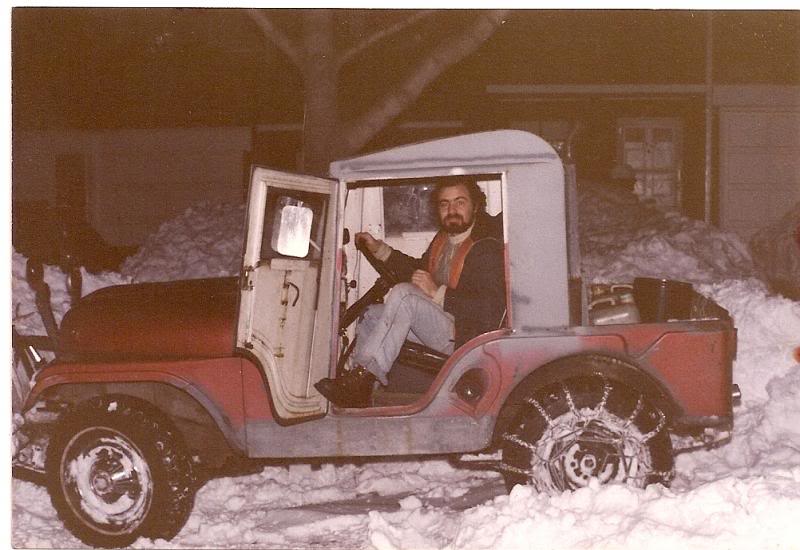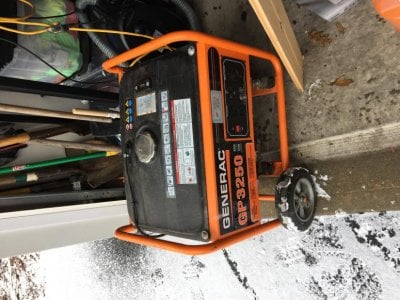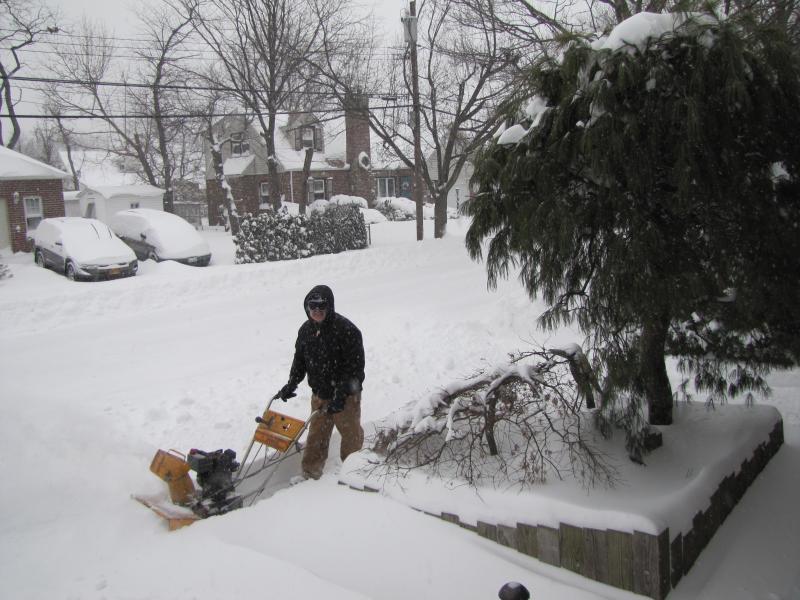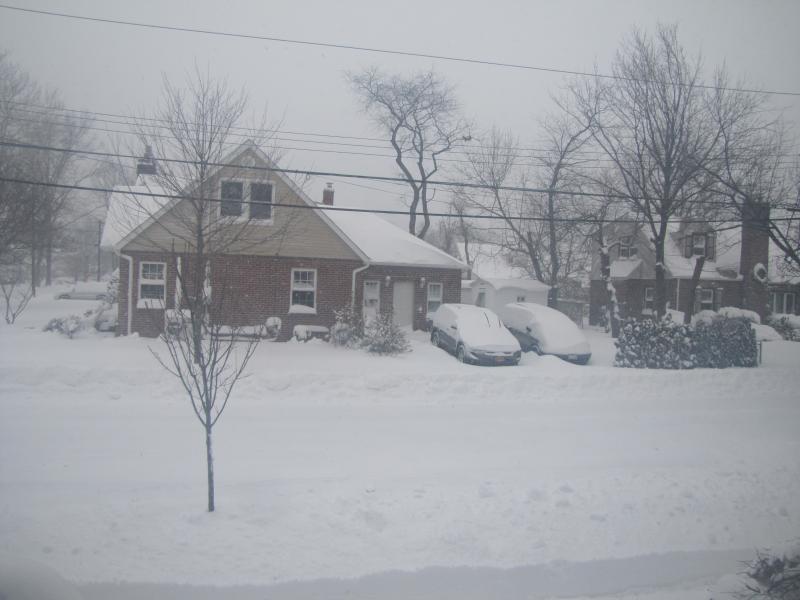Navigation
Install the app
How to install the app on iOS
Follow along with the video below to see how to install our site as a web app on your home screen.
Note: This feature may not be available in some browsers.
More options
You are using an out of date browser. It may not display this or other websites correctly.
You should upgrade or use an alternative browser.
You should upgrade or use an alternative browser.
Blizzard preparations
- Thread starter Randy Holmes-Farley
- Start date
- Tagged users None
Back in 1991 had an ice storm in Rochester, NY that took out power for up to 2 weeks for many in the area. Had my first 55g at the time. Woke up to the sounds of tree limbs coming down all around us and no power/no heat and outdoor temp of 30F. Tank was on an open metal stand so put 6 candles on the lower shelf of the stand about a foot and a half from bottom of the tank. We were one of a few lucky ones and had power back within 12 hours. Closely monitored tank temp and the candles provide enough heat to keep things stable. 8 hours into no power with indoor temp in mid 50's, was getting a little worried about no flow and O2. I started working on wiring my boats deep cycle battery (fully charged/in storage for winter) to a 100 watt DC/AC inverter. It was the sort that plugs into a car's cigarette lighter. Figured it would be enough to run an air pump and potentialy the very small pump that powered a HOB skimmer. It ran the air pump no problem but I never got around to hooking up a powerhead for flow as electric service came back on a few hours later.
I'm out of the path of the current storm, but it's got me thinking what I'd do if I lost power now. I have no generator or UPS. Don't think a UPS would have capacity to run things very long anyway. I do have 2 trucks full of gas most of the time and 2 x 12v auto style batteries for the boat in storage. My return pump is rated at 93 watts and heater is 150 watts. So looks like I'd need approx 250 watts to keep the essentials going. I have a small plug-in inverter of around 100 watts capacity. I think I'll be picking up a 400 watt inverter for emergencies. Seen them for about $50 with battery clamps. From there, alternate with the boat batteries and/or inverter direct to truck with engine idling. Not sure the heater would keep up if temp inside house dropped a lot. So I'd be insulating DT and sump as best I could and maybe resort to heating water in the fireplace and floating it in sump if needed.
Any electrical guys out there who might know how to calculate how long an automotive battery can supply 250 watts? Guessing there's some power loss to heat in the inverter as well.
I'm out of the path of the current storm, but it's got me thinking what I'd do if I lost power now. I have no generator or UPS. Don't think a UPS would have capacity to run things very long anyway. I do have 2 trucks full of gas most of the time and 2 x 12v auto style batteries for the boat in storage. My return pump is rated at 93 watts and heater is 150 watts. So looks like I'd need approx 250 watts to keep the essentials going. I have a small plug-in inverter of around 100 watts capacity. I think I'll be picking up a 400 watt inverter for emergencies. Seen them for about $50 with battery clamps. From there, alternate with the boat batteries and/or inverter direct to truck with engine idling. Not sure the heater would keep up if temp inside house dropped a lot. So I'd be insulating DT and sump as best I could and maybe resort to heating water in the fireplace and floating it in sump if needed.
Any electrical guys out there who might know how to calculate how long an automotive battery can supply 250 watts? Guessing there's some power loss to heat in the inverter as well.
I am ready. I just started my generator and gassed up my snow blower. I also cancelled a trip to the Florida Keys today. Of course my neighbors are all calling because they don't know how to start their blowers or generator. They have no gas, and already there are lines at the gas stations so I have to deal with all the people who wait for the biggest snow fall in New York history to get ready even though they predicted it a week ago. It amazes me. I am on my way to a neighbor now to connect his generator that he bought a year ago and is still in the box. I mean, Really! After Sandy I converted my generator to run on gasoline and natural gas and we have gas in the house for cooking and heat so I will run it on that. in the 70s I had a snow plowing business and on a day like today I would have made three or four months salary. But now I just snow blow it like everyone else with my 40+ year old snow blower.


Any electrical guys out there who might know how to calculate how long an automotive battery can supply 250 watts? Guessing there's some power loss to heat in the inverter as well.
Take the amp hour rating of the battery, multiply it by the voltage (12 for a 12 v battery) and thats the watt hours. IE the number of hours you can take 1 watt out, or the number of watts you can take for 1 hour.
So say you have a 70 amp hour (AH) battery, a large car battery that is, you say 70 * 12 = 840 watt hours. So say you are taking 200 watts, that means you will get 840 / 200 = 4.2 hours out of it.
The above is assuming 100% efficiency which you wont get. Inverters run from 80% to about 95% for the best, there will be some small losses in the battery too but probably not that much. Assuming a total efficiency of 80% that 4.2 hours becomes 4.2 * 0.8 = 3.36 hours (thats 3 hours 22 minutes, not 3 hours 36 minutes).
I think most inverters will survive being plugged into a slightly higher voltage from a battery under charge (a running car). The voltage off charge from a 12V battery is about 12V, but when its under charge (IE the engine is running) that will go up to about 14.4 volts. As I say though, although I havent tried it, most inverters should probably be able to take this without damage, as they are designed to survive inductive surges etc. So that means you should, if it comes to it, be able to plug your inverter (or converted UPS) into your car battery while the engine is running. Make sure the positive and negative are connected the right way round and improvise a fuse, like a short length of thin wire, if you don't have a fuse, because car batterys can deliver thousands of amps for a few seconds which can melt thick wires even.
While running at 2500 rpm or more the car alternator should be able to deliver 70 to 130 amps, so should recharge the 70 AH battery I discussed above in an hour or less. If the engine is at idle, it wont produce this. Its hard to say how much, but figure maybe 20 amps for safety, although its probably more. Bigger trucks have bigger alternators and supply more current.
Don't let the battery get deep discharged as it will damage it (IE dont run it flat). Keep recharging it by running the engine. Put the inverter close to the battery because you need thick wires from battery to inverter, thinner wires are ok from inverter to aquarium.
Take the amp hour rating of the battery, multiply it by the voltage (12 for a 12 v battery) and thats the watt hours. IE the number of hours you can take 1 watt out, or the number of watts you can take for 1 hour.
So say you have a 70 amp hour (AH) battery, a large car battery that is, you say 70 * 12 = 840 watt hours. So say you are taking 200 watts, that means you will get 840 / 200 = 4.2 hours out of it.
The above is assuming 100% efficiency which you wont get. Inverters run from 80% to about 95% for the best, there will be some small losses in the battery too but probably not that much. Assuming a total efficiency of 80% that 4.2 hours becomes 4.2 * 0.8 = 3.36 hours (thats 3 hours 22 minutes, not 3 hours 36 minutes).
I think most inverters will survive being plugged into a slightly higher voltage from a battery under charge (a running car). The voltage off charge from a 12V battery is about 12V, but when its under charge (IE the engine is running) that will go up to about 14.4 volts. As I say though, although I havent tried it, most inverters should probably be able to take this without damage, as they are designed to survive inductive surges etc. So that means you should, if it comes to it, be able to plug your inverter (or converted UPS) into your car battery while the engine is running. Make sure the positive and negative are connected the right way round and improvise a fuse, like a short length of thin wire, if you don't have a fuse, because car batterys can deliver thousands of amps for a few seconds which can melt thick wires even.
While running at 2500 rpm or more the car alternator should be able to deliver 70 to 130 amps, so should recharge the 70 AH battery I discussed above in an hour or less. If the engine is at idle, it wont produce this. Its hard to say how much, but figure maybe 20 amps for safety, although its probably more. Bigger trucks have bigger alternators and supply more current.
Don't let the battery get deep discharged as it will damage it (IE dont run it flat). Keep recharging it by running the engine. Put the inverter close to the battery because you need thick wires from battery to inverter, thinner wires are ok from inverter to aquarium.
Wow! Awesome explanation. Thanks. So if it comes down to it, I could safely guess at about 3 hours of 250 watts out of a typical auto battery?
Should do, with a new 70 AH battery, but thats the size of a battery in a 2.5 litre diesel. Older batteries AH goes down with age. Small gasoline car battery might be half that size probably. Truck maybe twice that or more! As I say though, err on the safe side because if you deep cycle these auto batterys they probably wont ever come back to the same capacity (the AH number shrinks with age, but if you deep cycle one, it can take tens of % off the capacity in one go which you wont ever get back).
Also if you have a small genny, the ones that put 12 volts out, if it can charge a battery (IE if its got a charging mode, or a charging output) then hook that up to a battery, and then hook that up to the inverter. IE set it up to charge the battery, and connect the inverter to the battery as if the genny was not connected. The battery will stabilise the voltage from the genny, which are pretty useless on their own. The reason for this is complicated but essentially the genny is bad at feeding a 'complex' load (reactive or with large surge currents). Its fine with a filament light bulb, but try to run a motor or inverter off one, for instance, and it can get in trouble. The battery isolates the genny and the load from each other. The genny is happy charging the battery, the inverter is happy taking power from the battery, but the inverter is usually not happy running from a cheap small genny without a battery to stabilise things. The actual reason is to do with the field winding current in a small cheap genny, its not stabilised and so as the inverter takes power, the field current goes down, the voltage drops, the inverter kicks out, then the field winding is again powered with more current, the voltage goes up, etc. I've tried it with a little 1kw genny and they are useless to run a motors or electronics. But with the battery to stabilise things, it works fine in my (one time) experience. This can run for days, long as you keep filling it with gas, and will give you around a kW with the size genny I used (I think the smallest you can get). It was £40 at the time so about $60.
I'll just reiterate though, playing around with car batterys is dangerous unless you are careful to have a fuse of some type. They can explode if short circuited for a few seconds, and thats not theoretical, it really does happen! So the best thing to do is always have some type of fuse, ideally right next to the battery, so its always in the loop (IE if you put a fuse far away from the battery, a short circuit in any place closer to the battery, wiring wise, will not be protected). A good enough fuse would be 6 inches of medium current wire, like you would run a light from or something. If its too thin, it will get hot, in which case just double or triple it up until it dosent get warm, then any current much over the normal load current will melt it (put it somewhere it can safely melt - not on a pile of paper in the house!).
Also if you have a small genny, the ones that put 12 volts out, if it can charge a battery (IE if its got a charging mode, or a charging output) then hook that up to a battery, and then hook that up to the inverter. IE set it up to charge the battery, and connect the inverter to the battery as if the genny was not connected. The battery will stabilise the voltage from the genny, which are pretty useless on their own. The reason for this is complicated but essentially the genny is bad at feeding a 'complex' load (reactive or with large surge currents). Its fine with a filament light bulb, but try to run a motor or inverter off one, for instance, and it can get in trouble. The battery isolates the genny and the load from each other. The genny is happy charging the battery, the inverter is happy taking power from the battery, but the inverter is usually not happy running from a cheap small genny without a battery to stabilise things. The actual reason is to do with the field winding current in a small cheap genny, its not stabilised and so as the inverter takes power, the field current goes down, the voltage drops, the inverter kicks out, then the field winding is again powered with more current, the voltage goes up, etc. I've tried it with a little 1kw genny and they are useless to run a motors or electronics. But with the battery to stabilise things, it works fine in my (one time) experience. This can run for days, long as you keep filling it with gas, and will give you around a kW with the size genny I used (I think the smallest you can get). It was £40 at the time so about $60.
I'll just reiterate though, playing around with car batterys is dangerous unless you are careful to have a fuse of some type. They can explode if short circuited for a few seconds, and thats not theoretical, it really does happen! So the best thing to do is always have some type of fuse, ideally right next to the battery, so its always in the loop (IE if you put a fuse far away from the battery, a short circuit in any place closer to the battery, wiring wise, will not be protected). A good enough fuse would be 6 inches of medium current wire, like you would run a light from or something. If its too thin, it will get hot, in which case just double or triple it up until it dosent get warm, then any current much over the normal load current will melt it (put it somewhere it can safely melt - not on a pile of paper in the house!).
Last edited:
i wonder how i will be in a year when i move to denver!
I was stationed there for 6 months. When I first got there I noticed they had like 15 foot high plows on the front of trains and I thought, that is ridiculous. Then the winter came :smow:
nano reefers would benefit well in preparation by having at least a full water change made up and ready to go, its the last line of CPR for the extended outage scenario where all other forms of support have timed out, and benthic losses are starting to compound.
even a brute container full and ready for your tank Randy imo is a strong last line of defense, its partial ammonia export, partial motion imparted and partial reoxygenation. for a nano reef, it could be full complements of these if full changes can be conducted, buying any amnt of time possible. waste build up toxicity w kill things quicker than cold in my past exp
in forgetting to re plug in my heater twice now in winter after water changes, Ive sustained every life form in my nano tank down to 68 degrees for three days. it then looked so bad in there I bothered to glance at the temp and see it was bad low, so mad at myself. plug back in, later on that day all fixed. all pods ophiuroids alive etc
even a brute container full and ready for your tank Randy imo is a strong last line of defense, its partial ammonia export, partial motion imparted and partial reoxygenation. for a nano reef, it could be full complements of these if full changes can be conducted, buying any amnt of time possible. waste build up toxicity w kill things quicker than cold in my past exp
in forgetting to re plug in my heater twice now in winter after water changes, Ive sustained every life form in my nano tank down to 68 degrees for three days. it then looked so bad in there I bothered to glance at the temp and see it was bad low, so mad at myself. plug back in, later on that day all fixed. all pods ophiuroids alive etc
Last edited:
Mike&Terry
Wrasses, Angels, & Tangs, Oh My!
View BadgesPartner Member 2024
Excellence Award
Reef Of The Month
Photo of the Month
Article Contributor
Moderator Emeritus
Battery air pumps are at the top of our list of must haves. We keep Penn Plax B11 Auto On Air Pump's on all of our tanks. They run on (2) D batteries and start automatically when the power shuts off. Ours were put through the test when Hurricane Irene hit in 2011.
The auto on feature with the Penn Plax B11 is nice, but any battery air pump will do. Walmart sells cheap battery powered air pumps for bait aeration. You can find them with fishing gear in the outdoor sports section. PetSmart may also be an option as they do carry this battery air pump in store:
Top Fin Battery Operated Aquarium Air Pump | Air Pumps & Air Stones | PetSmart
The auto on feature with the Penn Plax B11 is nice, but any battery air pump will do. Walmart sells cheap battery powered air pumps for bait aeration. You can find them with fishing gear in the outdoor sports section. PetSmart may also be an option as they do carry this battery air pump in store:
Top Fin Battery Operated Aquarium Air Pump | Air Pumps & Air Stones | PetSmart
that specific auto on unit has saved my tank before, we had a small 2 hour outage last month and it can go days on two d cells, i would esimate 48 hrs if good lithium ones or hq ones. my offbrand ones have been used for years now as backups and were basically full pump power when I got home during this last outage to see it working and alarm clocks flashing
I also have one of the Penn Plax B11 air pumps. That thing is awesome and runs for a very long time on a set of D cells.
I keep a small-ish (1400 running W) generator full of fuel on stand-by all winter long. It is more than enough to keep my tank going. As a backup to the backup, I also have a couple of inverters on hand.
I keep a small-ish (1400 running W) generator full of fuel on stand-by all winter long. It is more than enough to keep my tank going. As a backup to the backup, I also have a couple of inverters on hand.
We got a Sissy snow fall on Nassau Long Island. We got about 8". no where near the two feet they predicted. If you are old enough you know they always inflate snow predictions. I am not complaining about the snall snowfall, just the predictions.
They had predicted 12-24 inches here in Sayreville, NJ, but at best we got 4-5 inches.
I'm on the Ct coast. The snow in my driveway is to the top of the rim of the Tahoe which has 20" rims on it. Go to the back yard and parts of it you can see the ground
Similar threads
- Replies
- 6
- Views
- 148




















